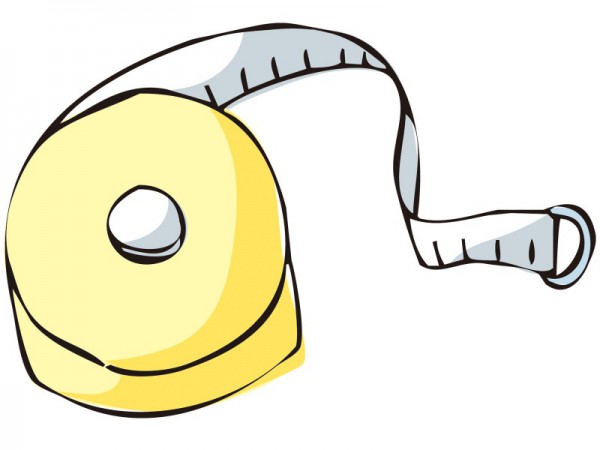
It is well-known that the Japanese counting system is very complicated because you have to change how to count depending on objects such as 個, 本, and つ. When it comes to how to measure, that’s simpler but you need to know which units Japanese people use, such as yards and meters, and how to say them in Japanese. That’s what you will learn here.
Japanese Measurement System for Length, Weight and Area
Japanese Basic Number System
| Numbers | Kanji | Readings |
|---|---|---|
| 1 | 一 | いち |
| 2 | 二 | に |
| 3 | 三 | さん |
| 4 | 四 | よん / し |
| 5 | 五 | ご |
| 6 | 六 | ろく |
| 7 | 七 | なな / ひち |
| 8 | 八 | はち |
| 9 | 九 | きゅう |
| 10 | 十 | じゅう |
As you can see the above, 4 can either be 「よん」 or 「し」 and 7 can either be 「なな」 or 「しち」. It is said that the reason why there are 2 ways is to avoid misleading your listeners by ambiguous sounds such as 「いち」 Vs 「しち」. And also, 「し」 is the same sound as 「死 (death)」. If you count 4 people as 「しにん」, it can be 「死人 (dead person)」. Therefore, when you count people, 「し」is never used. Although there are some exceptional situations, people prefer to use 「よん」and 「なな」 in general.
How to Measure Length in Japanese
| Numbers with Units | Readings *Spoken Language |
|---|---|
| 1 cm / m / km | いっせんち / いちめーとる / いっきろ |
| 2 cm / m / km | にせんち / にめーとる / にきろ |
| 3 cm / m / km | さんせんち / さんめーとる / さんきろ |
| 4 cm / m / km | よんせんち / よんめーとる / よんきろ |
| 5 cm / m / km | ごせんち / ごめーとる / ごきろ |
| 6 cm / m / km | ろくせんち / ろくめーとる / ろっきろ |
| 7 cm / m / km | ななせんち / ななめーとる / ななきろ |
| 8 cm / m / km | はっせんち / はちめーとる / はっきろ |
| 9 cm / m / km | きゅうせんち / きゅうめーとる / きゅうきろ |
| 10 cm / m / km | じゅっせんち / じゅうめーとる / じゅっきろ |
We use the metric system in Japan. As the chart indicates, when you use “cm” and “km” the めーとる is usually omitted. Also, contractions sometimes occur between numbers and units when the beginning sound of unit is an unvoiced sound.
Converter among Meter, Yard, and Feet
| Meter | Yard | Feet |
|---|---|---|
| 1 | 1.09 | 3.28 |
How to Measure Weight in Japanese
| Numbers with Units | Readings *Spoken Language |
|---|---|
| 1 g / kg | いちぐらむ / いっきろ |
| 2 g / kg | にぐらむ / にきろ |
| 3 g / kg | さんぐらむ / さんきろ |
| 4 g / kg | よんぐらむ / よんきろ |
| 5 g / kg | ごぐらむ / ごきろ |
| 6 g / kg | ろくぐらむ / ろっきろ |
| 7 g / kg | ななぐらむ / ななきろ |
| 8 g / kg | はちぐらむ / はっきろ |
| 9 g / kg | きゅうぐらむ / きゅうきろ |
| 10 g / kg | じゅうぐらむ / じゅっきろ |
Pay attention to whether the beginning sound of the unit is an unvoiced sound such as [k], [s], [t], [h], and [p]. Once you get used to these contractions, you’ll have an easier time with counters.
Converter among Kilogram, Ounce, and Pound
| Kilogram | Ounce | Pound |
|---|---|---|
| 1 | 35.27 | 2.20 |
How to Measure Area in Japanese
| Numbers with Units | Readings *Spoken Language |
|---|---|
| 1 m² / km² | いちへいべい / いちきろへいべい |
| 2 m² / km² | にへいべい / にきろへいべい |
| 3 m² / km² | さんへいべい / さんきろへいべい |
| 4 m² / km² | よんへいべい / よんきろへいべい |
| 5 m² / km² | ごへいべい / ごきろへいべい |
| 6 m² / km² | ろくへいべい / ろっきろへいべい |
| 7 m² / km² | ななへいべい / ななへいべい |
| 8 m² / km² | はちへいべい / はっきろへいべい |
| 9 m² / km² | きゅうへいべい / きゅうきろへいべい |
| 10 m² / km² | じゅうへいべい / じゅっきろへいべい |
Square meter and square kilometer are translated into Japanese as 「平方メートル」 and 「平方キロメートル」. However, there is another word 「平米」which is same as 「平方メートル」. In spoken Japanese, people prefer to use 「平米」 to 「平方メートル」 because it’s shorter. Moreover, there are Japanese unique measurement systems for area which are (unfortunately) still often used in everyday life. They are as follows.
Converter among Square Meter, Square Yard, Square Feet, 畳 and 坪
| Square meter | Square yard | Square feet | 畳 | 坪 |
|---|---|---|---|---|
| 1 | 1.19 | 10.76 | 0.54 | 0.30 |
Conclusion
When it comes to measurements, we think that getting used to them makes a difference. If you have difficulty at first, you may want to utilize a converter application for the time being. In any case, please try to keep using the Japanese measurements.
Recommended Links
How to Make a Phone Call in Japanese
